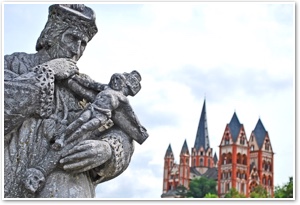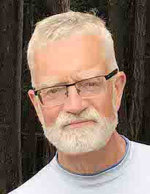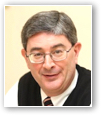Re-Forming the Church
- GEORGE WEIGEL
"Ecclesia semper reformanda": the Church always to be reformed.
 Well, of course. But today, as always, the question is, what makes for authentic reform in the Church? Perhaps a rabbinical story recounted in a popular 1950s Catholic novel, The Cardinal, helps focus the question.
Well, of course. But today, as always, the question is, what makes for authentic reform in the Church? Perhaps a rabbinical story recounted in a popular 1950s Catholic novel, The Cardinal, helps focus the question.
The scene set by author Henry Morton Robinson takes place in a New York hotel, where an early attempt at ecumenical reconciliation and interfaith dialogue, a kind of parliament of religions, is meeting. After numerous vacuous statements are made by this, that, or the other Christian cleric, an elderly rabbi gets up and tells a story.
There was a king, it seems, who owned a precious diamond that he cherished more than anything else in the world. One day, alas, a clumsy servant dropped the diamond, which was deeply scratched as a result. The finest jewelers in the kingdom were summoned to the palace, but despite their best efforts they could not repair the king's diamond. One day, however, an exceptionally skillful jeweler wandered into the kingdom and learned of the sad condition of the king's diamond. He volunteered his services — and by his marvelous, almost miraculous, craftsmanship, he carved onto the diamond a beautiful rose, rendering the deepest part of the scratch the rose's stem.
In the novel, the rabbi does not explicate his parable. But its meaning for a proper understanding of ecclesia semper reformanda should be obvious enough. All true reform in the Church is by reference to what is deepest in the Church: the "form" or constitution, which I use in its British, not American, sense, given to the Church by Christ the Lord. That deep "form" is the root from which the disfigurement of the Church can be transformed into renewal and reform.
Authentic Christian reform, in other words, is not a matter of human cleverness, and still less of human willfulness. If the Church is willed by Christ and empowered by the Holy Spirit, then authentic reform means recovering — making a source of renewal — some aspect or other of the Church's "form" that has been lost, marred, misconceived, or even forgotten. Authentic reform means reaching back and bringing into the future something that has been lost in the Church's present. Authentic ecclesial reform is always re-form.
We can see this process of re-forming the Church in late-twentieth-century Catholicism's embrace of religious freedom at the Second Vatican Council, and in the intellectual reclamation project that prepared the way for the Council's Declaration on Religious Freedom.
For a variety of historical reasons, including the Reformation and the wars of religion, early-modern Catholic church–state theory favored a confessional state in which political authority was wedded to spiritual authority and the state supported, promoted, and in some instances even enforced the Catholic Church's truth claims. Buttressing this institutional arrangement was a rationale: "error has no rights." The net result was what came to be known as the "thesis/hypothesis" model. The preferred arrangement, in which the Catholic Church enjoyed both the legal protection and financial support of the state, was the "thesis." Over against this thesis stood the "hypothesis": the confessionally neutral state, which could be tolerated if that was what historical contingency demanded.
Various new developments called this thesis/hypothesis model into question. Secularization in Europe in the nineteenth and twentieth centuries had not abated in countries where the Church still enjoyed state favor. There was the counter-experience of the United States, where the confessionally neutral state turned out to be very good for the Church, which was prospering and growing even as established churches in Europe were dying. And so Catholic reformers began to think what had once seemed unthinkable: that maybe establishment is a snare and delusion. If establishment sapped the Church's evangelical energies, perhaps the marriage of spiritual and political authority wasn't such a good idea after all. Concurrently, the notion that "error has no rights" began to be critiqued by theologians who insisted that persons had rights, even if their opinions were erroneous.
Above all, however, the reform of Catholic church–state theory that resulted in Vatican II's Declaration on Religious Freedom was due to a reclamation of a gospel truth that had, somehow, been lost in the flux of history: the act of faith, to be authentic, must be a free act. Coerced faith is no faith, or at best faux faith. "God wishes to be adored by people who are free," as the Congregation for the Doctrine of the Faith would later put it in the Instruction on Christian Freedom and Liberation.
Reform means reaching back and bringing into the future something that has been lost in the Church.
That understanding of the nature of faith — a free embrace of the offer of friendship and communion with the Son of God — is part of the Church's Christ-given "form." Retrieving it, and then applying it to contemporary social and political life, made the 1965 Declaration on Religious Freedom possible. The Catholic Church did not embrace religious freedom as a basic human right because it finally surrendered to Enlightenment political theory. The Catholic Church's affirmation of religious freedom was an authentic reform that re-formed Catholic church–state theory by retrieving a lost element of the Church's constitutive form and using that element as a means of genuine renewal.
As in every other moment in the Church's history, living the motto ecclesia semper reformanda in the twenty-first century will mean returning to the sources, the roots, of Christian faith.
This means, first of all, deepening the encounter with Jesus Christ. As Pope Benedict XVI never tired of repeating, Christianity does not begin with an idea or a program but with a person: the Second Person of the Holy Trinity, who walks along the Emmaus Roads of this century and invites all into the fellowship of his friends. A constantly re-forming Church is a Church always seeking the face of the Lord. Friendship with Jesus Christ is not only the beginning of the Church, but also the beginning of all authentic reform in the Church.
And as the Fathers of the Second Vatican Council taught, not least in their efforts to return the Bible to its rightful place in the Catholic Church's life, meeting the Lord means meeting him in his word, the revealed word of God in Holy Scripture. For from that meeting, we learn to see the world aright.
Original sin, we might say, is both the original myopia and the original astigmatism. Because of original sin, we see the world askew: the myopia of original sin gives us a squinty-eyed and narrow view of the world and ourselves, while the astigmatism of original sin further blurs and distorts our vision. In order to see the world (and ourselves) aright, we need corrective lenses. Those lenses are ground by an immersion in the Bible, through which we learn to see the world (and ourselves) in proper focus.
This is especially urgent in times of cultural confusion like our own. The culture of Me — the culture of the imperial autonomous Self, the culture of freedom understood as license and willfulness — envelopes the twenty-first-century West like a dense fog. Seeing through that fog requires a visual acuity that the world can not give. Seeing the world through biblical lenses — through the "inversions" of the Beatitudes, for example — cures our personal myopias and astigmatisms so that the deep truths of the human condition come into clearer focus.
Helping the people of the Church see the world aright through biblical lenses is the first task of the Church's preachers, and thus renewing homiletics must always be part of any authentic ecclesial reform. Preaching-as-therapy, preaching-as-political-education, even preaching-as-moral-exhortation — none of these is adequate to the homiletic task in a reforming Church today. If we would look for models of how expository, biblically rich preaching ought to be done, we can look to another root of the faith once delivered to the saints: the sermons of the great Church Fathers. They, too, sought to help their people see the world of late antiquity, in which old certainties and venerable institutions were crumbling, aright. Their world was not all that different from ours, in which truth is subjectivized and institutions once thought to be built into the human condition (like marriage and the family) are being deconstructed. And so immersion in patristic preaching can be a way to retrieve another lost element of the Church's form and make it into a source of renewal.
When Joseph Ratzinger was elected Bishop of Rome on April 19, 2005, both those who applauded the conclave's decision and those who deplored it dusted off their copies of a small book of the new pope's essays, Faith and the Future, and made a beeline for its last chapter, "What Will the Church Look Like in 2000?" There, both Ratzinger fans and Ratzinger critics found the passages that have become perhaps the most frequently cited of this great theologian's voluminous works:
From the crisis of today the Church of tomorrow will emerge — a Church that has lost much. She will become small and will have to start afresh more or less from the beginning. She will no longer be able to inhabit many of the edifices she built in prosperity. As the number of her adherents diminishes, so she will lose many of her social privileges. In contrast to an earlier age, she will be seen much more as a voluntary society, entered only by free decision. As a small society, she will make much bigger demands on the initiative of her individual members.… But in all the changes at which one might guess, the Church will find her essence afresh and with full conviction in that which was always at her center: faith in the triune God, in Jesus Christ, the Son of God made man, in the presence of the Spirit until the end of the world.…
But when the trial of this sifting is past, a great power will flow from a more spiritualized and simplified Church. Men in a totally planned world will find themselves unspeakably lonely. If they have completely lost sight of God, they will feel the full horror of their poverty. Then they will discover the little flock of believers as something wholly new. They will discover it as a hope that is meant for them, an answer for which they have always been searching in secret.
No serious Christian theologian, and certainly no pope, wants to shrink the Church: that we may take as axiomatic. What Ratzinger was outlining here was not a plan, but the reality of ecclesia semper reformanda in the late-modern and postmodern West. Genetically transmitted Christianity — the faith passed along by ethnic custom — was finished. Virtually no one in the Church of the twenty-first century, Ratzinger saw in 1970, would be able to answer the question, "Why are you a Christian?" by replying, "Because my great-grandmother was born in Bavaria" (or County Cork, or Cracow, or Guadalajara, or Palermo — or even South Boston). The only faith possible under late-modern and postmodern conditions is faith freely embraced in a free decision, made possible by an encounter with the risen Lord, Jesus Christ. Therefore, whatever institutions of ecclesial life would remain after what Ratzinger dubbed "the trial of this sifting" (which he believed had been underway for more than a century) would have to reconceive themselves as launching pads for mission, communities where those who had received the gift of faith would have to learn how to offer it to others. That gift would not bring with it, as in the past, social status. But it would bring something far more important: it would bring hope, rooted in faith and exercised in charity.
Both Ratzinger's papal predecessor and his papal successor have shared this vision, if with different accents. John Paul II called Catholicism — and by extension, all of Christianity — into a "New Evangelization" whose biblical metaphor was Luke 5:4: the Church must leave the shallow and brackish waters of institutional maintenance and, like the disciples on the Sea of Galilee, "put out into the deep" — the roiling, storm-tossed waters of a world that has lost its bearings. In what he has called the grand strategy document of his papacy, Evangelii Gaudium (The Joy of the Gospel), Pope Francis struck a similar note, calling for a "Church permanently in mission" in which the nobility of life displayed by Ratzinger's "little flock of believers" would touch the lives of the walking wounded of the postmodern world, and thereby offer what the world has been searching for, if unwittingly: friendship with Jesus Christ, who is the answer to the question that is every human life, and incorporation into the communion of his friends.
The only faith possible under late-modern and postmodern conditions is faith freely embraced in a free decision, made possible by an encounter with the risen Lord, Jesus Christ.
All of which is to say that the reformation we need at this quincentenary of Wittenberg is a re-formed Church of saints. The cultural dissolution of the West precludes arguing people into the faith. Very few people are going to be argued into belief in a world that accepts "your truth" and "my truth," but not the truth. Yes, the Church needs theologians. Yes, the Church needs fully catechized men and women who can make persuasive arguments, but what the reformed Church of the twenty-first century needs most are witnesses: men and women on fire with missionary zeal, because they have been embraced by the love of Christ and are passionate to share that love with others; men and women who see the world through a biblical optic; men and women sanctified by the sacraments; men and women who know, with Saint Paul, that the trials of the present age are preparing within the ecclesia semper reformandaan "eternal weight of glory" (2 Cor. 4:17).
 This is J. Fraser Field, Founder of CERC. I hope you appreciated this piece. We curate these articles especially for believers like you.
This is J. Fraser Field, Founder of CERC. I hope you appreciated this piece. We curate these articles especially for believers like you.
Please show your appreciation by making a $3 donation. CERC is entirely reader supported.

Acknowledgement
 George Weigel. "Re-Forming the Church." Plough Quarterly No. 14 (Autumn 2017).
George Weigel. "Re-Forming the Church." Plough Quarterly No. 14 (Autumn 2017).
Reprinted with permission of George Weigel and Plough Quarterly. The original article can be found here.
Plough Quarterly is a magazine of stories, ideas, and culture to inspire faith and action. Bold, hope-filled, and down-to-earth, it features thought-provoking articles, commentary, interviews, short fiction, book reviews, poetry and art.
The Author

 George Weigel is a Distinguished Senior Fellow of the Ethics and Public Policy Center in Washington, D.C. He is author of The Fragility of Order: Catholic Reflections on Turbulent Times; Lessons in Hope: My Unexpected Life with St. John Paul II; Evangelical Catholicism: Deep Reform in the 21st-Century Catholic Church; Witness to Hope: The Biography of Pope John Paul II; Roman Pilgrimage: The Station Churches; Evangelical Catholicism; The End and the Beginning: John Paul II—The Victory of Freedom, the Last Years, the Legacy; God's Choice: Pope Benedict XVI and the Future of the Catholic Church; Letters to a Young Catholic: The Art of Mentoring; The Courage to Be Catholic: Crisis, Reform, and the Future of the Church; and The Truth of Catholicism: Ten Controversies Explored.
George Weigel is a Distinguished Senior Fellow of the Ethics and Public Policy Center in Washington, D.C. He is author of The Fragility of Order: Catholic Reflections on Turbulent Times; Lessons in Hope: My Unexpected Life with St. John Paul II; Evangelical Catholicism: Deep Reform in the 21st-Century Catholic Church; Witness to Hope: The Biography of Pope John Paul II; Roman Pilgrimage: The Station Churches; Evangelical Catholicism; The End and the Beginning: John Paul II—The Victory of Freedom, the Last Years, the Legacy; God's Choice: Pope Benedict XVI and the Future of the Catholic Church; Letters to a Young Catholic: The Art of Mentoring; The Courage to Be Catholic: Crisis, Reform, and the Future of the Church; and The Truth of Catholicism: Ten Controversies Explored.


